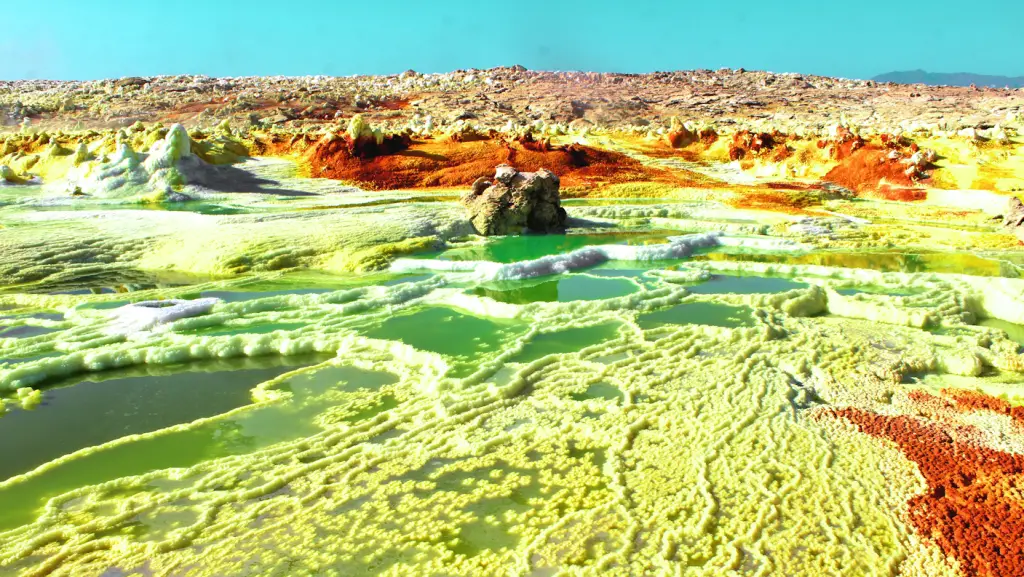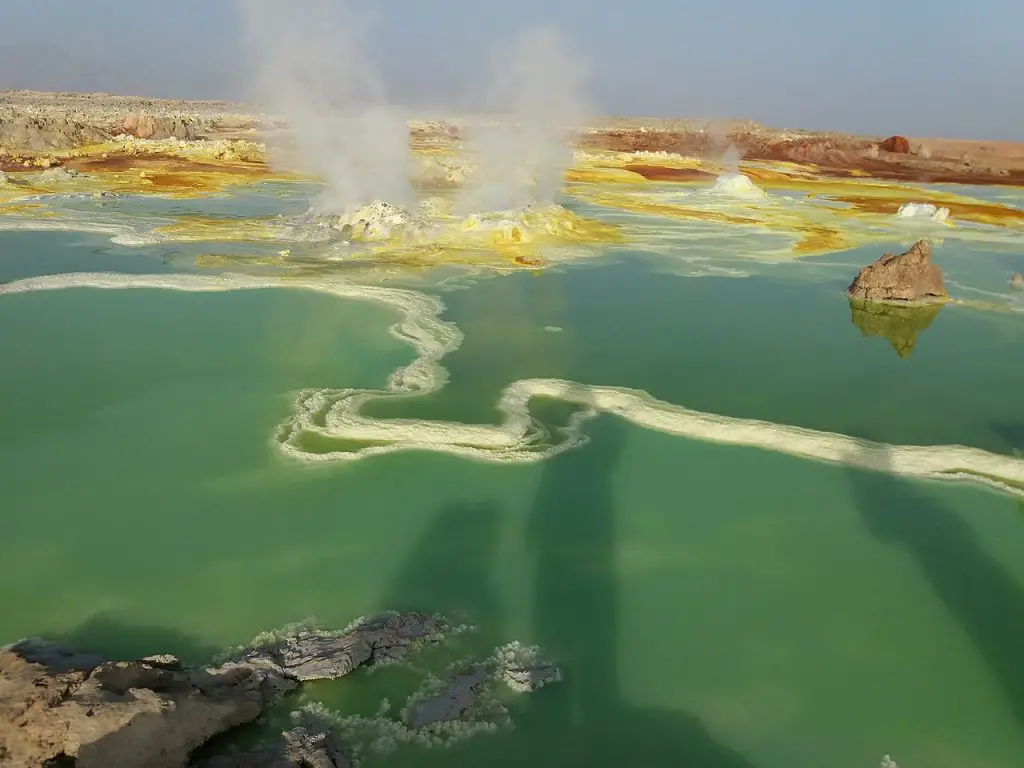 ave you ever wondered what the hottest place on Earth is? Well, look no further than Dallol in northern Ethiopia. This remote and desolate location has an average temperature of 34°C (93°F) and can reach a scorching 46°C (115°F) during the summer months. But why is it so hot here? Let’s explore the causes of these extreme temperatures, the unique atmospheric conditions, and their impact on local wildlife and communities. Share this article to learn more about why Dallol is officially the hottest place on Earth!
ave you ever wondered what the hottest place on Earth is? Well, look no further than Dallol in northern Ethiopia. This remote and desolate location has an average temperature of 34°C (93°F) and can reach a scorching 46°C (115°F) during the summer months. But why is it so hot here? Let’s explore the causes of these extreme temperatures, the unique atmospheric conditions, and their impact on local wildlife and communities. Share this article to learn more about why Dallol is officially the hottest place on Earth!
Overview of Dallol

Nestled within the Afar Triangle of northern Ethiopia, lies Dallol – the hottest place on Earth. This remote and desolate location has an average temperature of 34°C (93°F) and can reach a scorching 46°C (115°F) during the summer months. But why is it so hot here?
The extreme climate of Dallol is due to its location in the lowest point of the Danakil Depression, combined with over 300 days of sunshine each year. The area also experiences almost no precipitation, making it even more inhospitable for human life. In fact, Dallol is one of the driest places on Earth!
The unique atmosphere of Dallol is further enhanced by its volcanic activity and geothermal springs. One such example is Dallol Volcano which last erupted in 1926 and still emits sulfuric gases today. Other geothermal springs can be found throughout this region, providing evidence that this area was once covered by an ancient lake or sea.
In 2013, the World Meteorological Organization officially declared Dallol as “the hottest place on Earth” due to its average temperature reaching up to 34.4 °C (94 °F). Despite its harsh climate, people continue to live in this isolated part of Ethiopia – living off livestock herding and salt mining along the nearby salt flats.
Dallol is a unique environment like few others on our planet – an extreme combination of heat, volcanoes and salt flats which have created a remarkable landscape unlike any other place on Earth!
Temperature Extremes in Dallol

Dallol, Ethiopia is known for having some of the hottest temperatures on Earth. Its average maximum temperature is 97°F (36°C) with the highest ever recorded there being 94°F (34.4°C). This makes it even hotter than Death Valley in California, which holds the record for the highest temperature ever recorded at 134°F (56.7°C).
The extreme temperatures in Dallol are due to its location in the lowest point of the Danakil Depression and over 300 days of sunshine each year and almost no precipitation. The unique atmosphere of Dallol is enhanced by its volcanic activity and geothermal springs, such as the Dallol Volcano which last erupted in 1926. The salt flats, combined with lack of vegetation and shade create a unique environment that has an impact on local wildlife and communities.
The intense heat affects everything from how people dress to how they manage their livestock herding and salt mining activities along the nearby salt flats. For example, people living in this environment must wear clothing that covers their skin from head to toe to protect them from sunburns or heat stroke while they work outdoors. They also have to plan their water usage carefully as water sources can be scarce during certain times of year when temperatures soar above 100 degrees Fahrenheit.
The high temperatures also impact other activities such as farming, which requires irrigation systems that use up precious resources like water, making it difficult for farmers to produce enough food for their families or livestock during periods of extreme heat. Despite these challenges faced by locals due to extreme weather conditions, people continue to live in this isolated part of Ethiopia where they rely on traditional methods such as herding livestock or mining salt to make a living.
Causes of the High Temperatures

The extreme temperatures in Dallol are caused by a number of factors, which all contribute to the unique atmosphere of this region. Firstly, there is the volcanic activity in the area which produces heat from magma and geothermal springs. Secondly, the air in this region is very dry and traps heat, leading to higher temperatures than other areas that have more moisture in their air. Thirdly, the salt flats absorb a lot of heat from the sun’s rays, making it even hotter than areas with less salt deposits. Finally, due to its lack of vegetation and shade, more sunlight is able to reach the ground during the day – further contributing to high temperatures.
In addition to these local factors, Dallol’s location near the equator also causes higher temperatures than other areas at similar latitudes. This is because sunlight provides more energy at low latitudes compared to those at higher latitudes. As a result, this increases air temperature and evaporation rate – both of which are key elements for creating an environment suitable for extreme heat conditions like those found in Dallol.
Overall, it can be seen that Dallol’s high temperatures are due to its combination of local features such as its volcanic activity and lack of vegetation combined with being located near the equator- both of which allow for more intense sunshine throughout the year.
Unique Atmospheric Conditions in Dallol

Dallol, located in the Afar Triangle of northern Ethiopia, is a unique environment due to its extreme temperatures, lack of vegetation, and volcanic activity. The area has an average air pressure that is significantly higher than anywhere else on Earth, with relative humidity levels rarely reaching above 8%. This creates an incredibly dry atmosphere with dust storms occurring frequently because of high winds and sandy terrain.
The average temperature of 34°C (93°F) can reach up to 46°C (115°F) during summer, making it one of the hottest places on Earth. This heat combined with strong solar radiation can lead to skin rashes and damage to electronic devices if people are not careful. Despite these extreme conditions, people still live in this isolated part of Ethiopia as they rely on livestock herding and salt mining along the nearby salt flats for their livelihoods.
Due to its unique atmospheric conditions, Dallol provides an opportunity for scientific exploration into how living things have adapted to such harsh climates. Its extreme temperatures and sparse vegetation also make it a popular destination for photographers looking to capture its stunning landscapes and vibrant colors. With more research being done in the area every year, we may be able to unlock even more secrets about this remarkable place on our planet.
Impact on Local Wildlife and Communities

Living in an environment with extreme temperatures can have a profound impact on local wildlife, vegetation, and communities. The high temperatures of Dallol have caused a decrease in certain species of wildlife that are unable to survive such conditions. In addition, there is very little vegetation due to the difficulty for plants to thrive in such an environment.
Humans living in the area face several health risks due to the extreme heat. These include heat exhaustion, dehydration and sunburn from prolonged exposure to the hot climate. Farmers are also unable to grow crops, causing food insecurity for those living in the area. Furthermore, long-term damage can be inflicted upon buildings and infrastructure as a result of intense temperatures over time.
For those who live in Dallol, their livelihoods depend on adapting to the climate or finding other sources of income such as livestock herding or salt mining near the salt flats. Protective clothing and regular hydration are essential for anyone visiting or living in this extreme environment, while they must also be aware of potential health issues that could arise from spending too much time outdoors without adequate protection from the sun’s rays.
The intense climate of Dallol provides an opportunity for exploration into how humans can survive and adapt despite challenging conditions – something which has been tested by locals since before recorded history began. Despite its harshness, it remains a place full of beauty and vibrant colors that make it a popular destination for photographers looking to capture unique landscapes on film or digital media.
Avid Writer with invaluable knowledge of Humanity!
Upcoming historian with over 30 million views online.
“You make your own life.”





